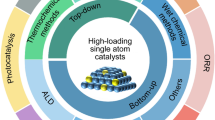Abstract
One of the barriers for wide usage of hydrogen energy system is efficient storage. To store more hydrogen efficiently, physisorption is a choice among the others with high storage performance, reversibility, and lifecycles. Metal organic framework (MOF) structured organometallic orotate-Co(II) complexes could serve as sorbents which store hydrogen by physisorption. In this work, mono- and bidentate MOF structured orotate-Co(II) complexes are synthesized, characterized, and then investigated for hydrogen storage experimentally and theoretically. It is found that these compounds could store hydrogen. Especially, the monodentate complex could uptake hydrogen better than the other. Storage performances for mono- and bidentate complexes were 0.80 and 1.15 wt% at 77 K and approximately 80 bars experimentally, 1.03 and 1.16 wt% theoretically for the same conditions.









Similar content being viewed by others
References
M.G. Nijkamp, J.E.M.J. Raaymakers, A.J. van Dillen, and K.P. Jong: Hydrogen storage using physisorption - materials demands. Appl. Phys. A 72, 619–623 (2001).
F.G. Cirujano, F.X.L. Xamena, and A. Corma: MOFs as multifunctional catalysts: One-pot synthesis of menthol from citronellal over a bifunctional MIL-101 catalyst. Dalton Trans. 41, 4249–4254 (2012).
B. Liu: Metal–organic framework-based devices: Separation and sensors. J. Mater. Chem. 22, 10094 (2012).
J.R. Li, R.J. Kuppler, and H.C. Zhou: Selective gas adsorption and separation in metal–organic frameworks. Chem. Soc. Rev. 38, 1477 (2009).
S. El-Safty: Organic–inorganic hybrid mesoporous monoliths for selective discrimination and sensitive removal of toxic mercury ions. J. Mater. Sci. 44, 6764 (2004).
Y. Li and R.T. Yang: Gas adsorption and storage in metal−organic framework MOF-177. Langmuir 23(26), 12937 (2007).
J. An and N.L. Rosi: Tuning MOF CO2 adsorption properties via cation exchange. J. Am. Chem. Soc. 132(16), 5578 (2010).
H. Wu, W. Zhou, and T. Yildirim: High-capacity methane storage in metal-organic frameworks M2(dhtp): The important role of open metal sites. J. Am. Chem. Soc. 131(13), 4995 (2009).
N.L. Rosi, J. Eckert, M. Eddaoudi, D.T. Vodak, J. Kim, M. O’Keeffe, and O.M. Yaghi: Hydrogen storage in microporous metal-organic frameworks. Science 300(5622), 1127 (2003).
B. Zheng, R. Yun, J. Bai, Z. Lu, L. Du, and Y. Li: Expanded porous MOF-505 analogue exhibiting large hydrogen storage capacity and selective carbon dioxide adsorption. Inorg. Chem. 52(6), 2823 (2013).
A.K. Singh and B.I. Yakobson: First principles calculations of H-storage in sorption materials. J. Mater. Sci. 47, 7356 (2012).
W.X. Lim, A.W. Thornton, A.J. Hill, B.J. Cox, J.M. Hill, and M.R. Hill: High performance hydrogen storage from be-BTB metal–organic framework at room temperature. Langmuir 29(27), 8524 (2013).
Q. Yang and C. Zhong: Molecular simulation of adsorption and diffusion of hydrogen in metal-organic frameworks. J. Phys. Chem. B 109(24), 11862 (2005).
W.L. Jorgensen, D.S. Maxwell, and J. Tirado-Rives: Development and testing of the OPLS all-atom force field on conformational energetics and properties of organic liquids. J. Am. Chem. Soc. 118, 11225 (1996).
S. Lencioni, A Pellerito, T. Fiore, A.M. Giuliani, L. Pellerito, M.T. Cambria, and C. Mansueto: Organometallic complexes with biological molecules. X: Dialkyltin(IV) and trialkyltin(IV) orotates: Spectroscopic and in vivo investigations. Appl. Organometal. Chem. 13(3), 145 (1999).
A.J. Darensbourg, D.L. Larkins, and J.H. Reibenspies: Bis(triphenylphosphine)copper(I) complexes of orotate and L-dihydroorotate. Inorg. Chem. 37(23), 6125 (1998).
D.A. Kose, K.B. Zumreoglu, O. Sahin, and O. Buyukgungor: Transition metal(II) complexes of vitamin B13 with monodentate orotate(1−) ligands. J. Mol. Struct. 789(1–3), 147 (2006).
O. Sahin, O. Buyukgungor, D.A. Kose, K.B. Zumreoglu, and H. Necefoglu: Catena-poly[[[triaquacobalt(II)]-mu-2,6-dioxo-1,2,3,6-tetrahydropyrimidine-4-carboxylato(2-)] 1.72-hydrate]. Acta Cryst. C62, 513 (2006).
S.S. Kaye, A. Dailly, O.M. Yaghi, and J.R. Long: Impact of preparation and handling on the hydrogen storage properties of Zn4O(1,4-benzenedicarboxylate)3 (MOF-5). J. Am. Chem. Soc. 129, 14176 (2007).
J. Rouquerol, D. Avnir, C.W. Fairbridge, D.H. Everett, J.M. Haynes, N. Pernicone, J.D.F. Ramsay, K.S.W. Sing, and K.K. Unger: Recommendations for the characterization of porous solids (technical report). Pure Appl. Chem. 66(8), 1739 (1994).
B. Assfour, S. Leoni, S. Yurchenko, and G. Seifert: Hydrogen storage in zeolite imidazolate frameworks. A multiscale theoretical investigation. Int. J. Hydrogen Energy 36(10), 6005 (2011).
Acknowledgments
This research was funded by TUBITAK with 111T608 project number. We also acknowledge UNIDO-ICHET for their support and serving their laboratory.
Author information
Authors and Affiliations
Corresponding author
Supplementary Material
Supplementary Material
To view supplementary material for this article, please visit https://doi.org/10.1557/jmr.2013.357
Rights and permissions
About this article
Cite this article
Ozturk, Z., Kose, D.A., Asan, A. et al. Hydrogen storage properties of mono- and bidentate MOF structured orotate complexes. Journal of Materials Research 29, 215–220 (2014). https://doi.org/10.1557/jmr.2013.357
Received:
Accepted:
Published:
Issue Date:
DOI: https://doi.org/10.1557/jmr.2013.357




